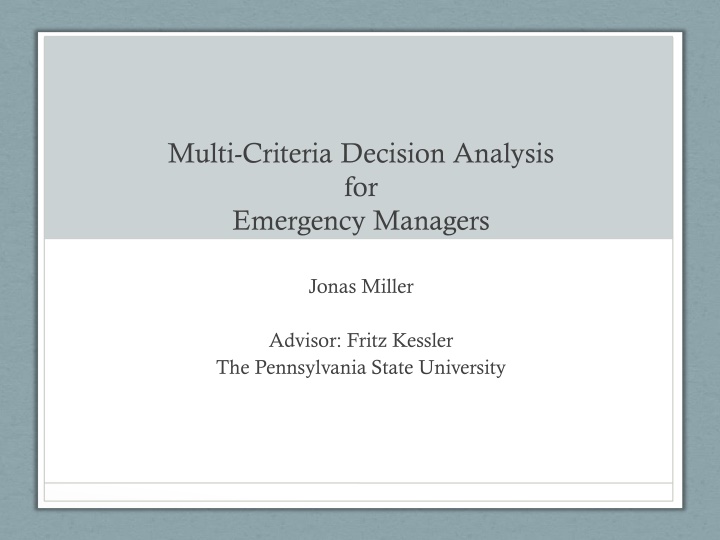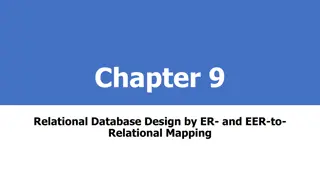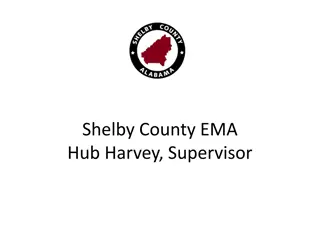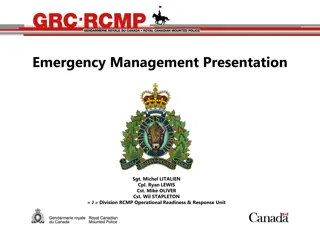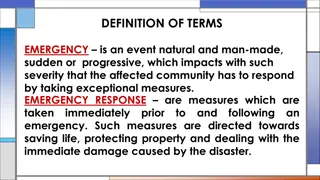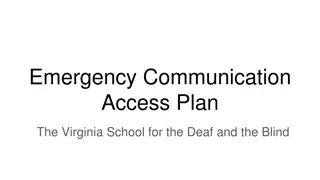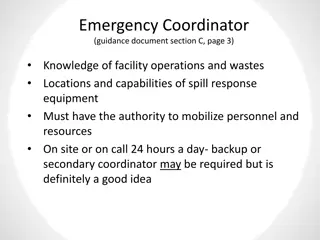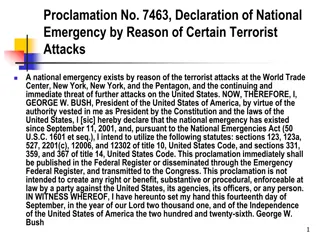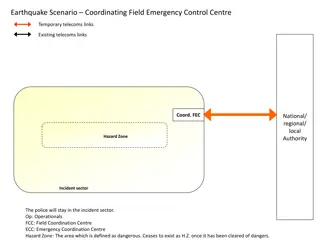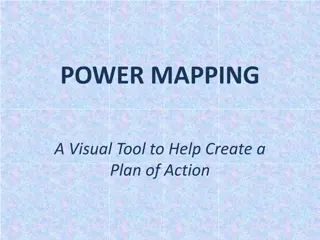Leveraging Multi-Criteria Decision Analysis for Emergency Response Mapping
Explore how local emergency managers in Oso, Washington, can utilize their expertise and GIS to create initial risk maps for mudslides. Discover the process of identifying high-consequence areas through the evaluation of available data layers and application of overlay weights based on personal knowledge. This project aims to enhance on-the-fly decision-making capabilities for emergency managers at the local level.
Download Presentation

Please find below an Image/Link to download the presentation.
The content on the website is provided AS IS for your information and personal use only. It may not be sold, licensed, or shared on other websites without obtaining consent from the author.If you encounter any issues during the download, it is possible that the publisher has removed the file from their server.
You are allowed to download the files provided on this website for personal or commercial use, subject to the condition that they are used lawfully. All files are the property of their respective owners.
The content on the website is provided AS IS for your information and personal use only. It may not be sold, licensed, or shared on other websites without obtaining consent from the author.
E N D
Presentation Transcript
Multi-Criteria Decision Analysis for Emergency Managers Jonas Miller Advisor: Fritz Kessler The Pennsylvania State University
Scenario Local emergency manager in Oso, Washington is concerned with the risk of mudslide from week of sustained heavy rainfall. How can local emergency managers leverage their experience/expertise and GIS to create a initial response risk map? How can this emergency manager identify areas with the greatest consequences of resource (natural, infrastructure, personnel) loss?
2014 Oso, Washington Mudslide Managers could quickly assess the risks of a mudslide by overlaying relevant layers: Topography locations where damage would be greatest/least Soil type Where is the greatest probability of landslide occurrence? Population who will be impacted the greatest/least by a landslide? Associated Press
Objective Eavluate an on-the fly Multi-criteria decision analysis (MCDA) workflow with local level (municipality/county) emergency managers The evaluation included: Designing a customizable selection of publically available data layers Apply overlay weights to data layers based on user s personal subject knowledge / experience / emergency situation
Project Overview Identify the need for a initial emergency response mapping tool Review relevant literature Describe a target user Assess target user s needs/capabilities Determine available, accessible, and free data Develop model Test model Validate model
MCDA Defined From Huang et al. (2011): systematic methodology to combine multiple factors assigns scores to inputs across possible outcomes combined by a linear weighted sum Huang, I., Kiesler, J. & Linkov, I. (2011). Multi-criteria decision analysis in environmental science: Ten years of applications and trends. Science of the Total Environment, 409:3578-3594.
Risk Defined Risk = consequences of expected losses Previous studies of risk mapping: Defined risk in the form of susceptibility mapped for single hazards: Landslides, pipeline oil spills, tropical storm impact Maps created using overlays of multiple features related to hazard Geomorphology, Population Density, Soil Characteristics, Hydrology
Previous Studies Jafari et al. (2010): Iranian Pipeline study incorporating complex, multifactor environmental risk factor Poompavai et al. (2013): Indian Cyclone study introducing population-specific risk factors coping with equally weighted categories Jafari, J., Khorasani, N., & Danehkar, A. (2010). Using environmental sensitivity index (ESI) to assess and manage environmental risks of pipelines in GIS environment: A case study of a near coastline and fragile ecosystem located pipeline. World Academy of Science, Engineering and Technology, 44:1101-1111. Poompavai, V. & Ramalingam, M. J. (2013). Geospatial Analysis for Coastal Risk Assessment to Cyclones. Indian Society of Remote Sensing, 41:157-176. doi:10.1007/s12524-011-0198-8.
Previous Studies Alexander (2010): UK study of a emergency response mapping tool with end-user input and feedback Ahmed (2015): User generated weighting of factors for Bangladeshi Landslides; concluded complete model requires input from both local officials and academic subject matter expertise
Identify Target End User Local emergency manager with basic understanding of GIS and expertise and experience in emergency / disaster response Timeframe: within first few (up to 12) hours of a response, before state/federal resources arrive Scope: local geographic level Municipality, County
Review Publically Available Emergency Management Data Layers ArcGIS Open Data: 56,470 datasets ranging from local to national scale Dept. of Homeland Security (DHS): Homeland Infrastructure Foundation Level Data (HIFLD) Open: 267 DHS supported datasets on national scale
Creating a Risk Map 1. Select data from publically available layers (HIFLD or ArcGIS Open Data) 2. Convert to raster: Feature to Raster or Euclidian Distance (for distance based risks) Tools 3. Apply Reclassify Tool to achieve same scale (0-9 based on suggested ArcGIS Help/ESRI Public Safety Team workflow) 4. Combine reclassified layers with Weighted Overlay Tool for Final Risk Index map
Limitations End user requires baseline understanding of GIS Subjective selection of layers and weights How the layers are combined Type of feature (polygons/lines only) Scale of model (work with local datasets)
User Testing Distributed to local emergency managers in greater Philadelphia Area - 8 total respondents - Mixture of Senior Emergency Managers and GIS Specialists Example Respondent: Delaware County Senior Emergency Manager Experience: 20+ Years Basic Understanding of GIS Products
Survey Content Questions: General Information/Experience/Knowledge of GIS Explanation of Open Source Online Data Explanation of MCDA and Example Workflow Flooding and Hazardous Materials Release Scenarios Selection, Ranking, and Weighting (Perceived Importance) of Layers Feedback on Workflow Process/Survey
Scenario 1: Flooding Scenario: major flooding as the result of river/stream overflow near major transportation infrastructure Most Common Category Layers 1) Census/Population 2) Transportation Infrastructure 3) Land Use/Parcel
Scenario 1: Flooding Sample Classification Layer Weight Negative slope: 10 No slope: 5 Positive slope: 1 Private: 1 Non-Arterial: 5 Arterial: 10 1-1000: 1 1000-3000: 3 3000-6000: 6 6000-9000: 9 >9000: 10 Elevation 0.5 Roads 0.2 Population 0.3
Scenario 2: Hazardous Materials (Hazmat) Release Scenario: Hazmat release from a tank truck or rail car in vicinity of a populated area Most Common Category Layers 1) Population 2) Land Use 3) Elevation
Scenario 2: Hazardous Materials (Hazmat) Release Sample Classification Layer Weight 1-1000: 1 1000-3000: 3 3000-6000: 6 6000-9000: 9 >9000: 10 Commercial: 3 Public: 5 Residential: 10 Negative slope: 10 No slope: 5 Positive slope: 1 Population 0.6 Land Use 0.2 Elevation 0.2
Scenario 2: Hazardous Materials (Hazmat) Release
Feedback from Users Several emergency managers view GIS as a series of products from the specialists Well-documented justification for selection of layers General understanding of MCDA methodology and purpose Critical feedback was on scenario detail (specifics of flooding and the type of hazardous material?)
Lessons Learned GIS is staffed but not widely funded or utilized on local response level City of Camden, Burlington County Personal ArcGIS Online accounts Evaluation method was too broad Written survey may have made it harder to visualize intended results Solution: GUI (graphic user interface) or use the actual ArcGIS Toolbox (dropdowns, data imports) to direct results
Further Research Hosted Geoprocessing Service (in development) Application of on-the-fly MCDA to broader GIS user base- Average personal user with access to ArcGIS Online can answer geospatial questions: Public Transit Traffic Safety Real Estate Politics Law Enforcement
References Abuzied, S., Yuan, M., Ibrahim, S., et al. Journal of Arid Environments (2016) 133: doi:10.1016/j.jaridenv.2016.06.004 Special Acknowledgement to the ESRI Public Safety Team for consultation and guidance of the development of the ArcGIS Workflow Aubrecht, C., zceylan, D., Steinnocher, K. et al. Natural Hazards (2013) 68: 147. doi:10.1007/s11069-012-0389- 9. Environmental Systems Research Institute (ESRI), (2016). ArcGIS Desktop Help 10.4 Spatial Analyst.http://resources.arcgis.com/en/help/main/10.4 /index.html U.S. Department of Homeland Security, Federal Emergency Management Agency (2013). National Response Framework, pp. 2-13. U.S. Department of Homeland Security, Homeland Infrastructure Foundation Level Data (2016). Geospatial Management Office. Available online at https://hifld- dhs-gii.opendata.arcgis.com/.
Questions? Associated Press
